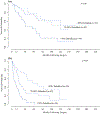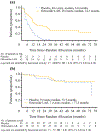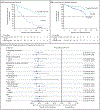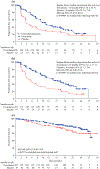The Landmark Series: Management of Small Bowel Neuroendocrine Tumors
- PMID: 33452604
- PMCID: PMC8604156
- DOI: 10.1245/s10434-020-09566-4
The Landmark Series: Management of Small Bowel Neuroendocrine Tumors
Abstract
Surgical resection is the foundation for treatment of small bowel neuroendocrine tumors (SBNETs). Guidelines for surgical management of SBNETs rely on retrospective data, which suggest that primary tumor resection and cytoreduction improve symptoms, prevent future complications, and lengthen survival. In advanced NETs, improvement in progression-free survival has been reported in large, randomized, controlled trials of various medical treatments, including somatostatin analogues, targeted therapy, and peptide receptor radionuclide therapy. This review discusses important studies influencing the management of SBNETs and the limitations of current evidence regarding surgical interventions for SBNETs.
Figures





Similar articles
-
Management of Small Bowel Neuroendocrine Tumors.Surg Oncol Clin N Am. 2020 Apr;29(2):223-241. doi: 10.1016/j.soc.2019.11.006. Surg Oncol Clin N Am. 2020. PMID: 32151357 Review.
-
Systemic Therapy of Advanced Well-differentiated Small Bowel Neuroendocrine Tumors Progressive on Somatostatin Analogues.Curr Treat Options Oncol. 2022 Sep;23(9):1233-1246. doi: 10.1007/s11864-022-00998-6. Epub 2022 Aug 8. Curr Treat Options Oncol. 2022. PMID: 35939200 Review.
-
Small bowel neuroendocrine tumors: Unique features and low lethality compared with small bowel adenocarcinoma.J Gastroenterol Hepatol. 2024 Dec;39(12):2597-2608. doi: 10.1111/jgh.16740. Epub 2024 Sep 16. J Gastroenterol Hepatol. 2024. PMID: 39285515
-
Antiproliferative Systemic Therapies for Metastatic Small Bowel Neuroendocrine Tumours.Curr Treat Options Oncol. 2021 Jun 29;22(8):73. doi: 10.1007/s11864-021-00863-y. Curr Treat Options Oncol. 2021. PMID: 34185197 Review.
-
Update on medical treatment of small intestinal neuroendocrine tumors.Expert Rev Anticancer Ther. 2016 Sep;16(9):969-76. doi: 10.1080/14737140.2016.1207534. Epub 2016 Jul 13. Expert Rev Anticancer Ther. 2016. PMID: 27353232 Review.
Cited by
-
Association Between Female Sex and Better Survival in Gastroenteropancreatic Neuroendocrine Tumors.J Surg Res. 2024 Oct;302:53-63. doi: 10.1016/j.jss.2024.07.012. Epub 2024 Jul 30. J Surg Res. 2024. PMID: 39083906
-
Multiomic sequencing of paired primary and metastatic small bowel carcinoids.F1000Res. 2023 Oct 4;12:417. doi: 10.12688/f1000research.130251.2. eCollection 2023. F1000Res. 2023. PMID: 37954063 Free PMC article.
-
Small bowel neuroendocrine neoplasm: what surgeons want to know.Abdom Radiol (NY). 2022 Dec;47(12):4005-4015. doi: 10.1007/s00261-022-03485-6. Epub 2022 Mar 21. Abdom Radiol (NY). 2022. PMID: 35312820 Review.
-
MOLECULAR IMAGING AND THERAPY IN AN UNRESPONSIVE CASE WITH MULTISYSTEMIC METASTATIC ILEAL NEUROENDOCRINE TUMOR.Acta Endocrinol (Buchar). 2024 Jul-Sep;20(3):388-392. doi: 10.4183/aeb.2024.388. Epub 2025 May 23. Acta Endocrinol (Buchar). 2024. PMID: 40530098 Free PMC article.
-
Unveiling a Small Bowel Obstruction: A Case of a Neuroendocrine Ileal Tumor.Cureus. 2024 Aug 11;16(8):e66646. doi: 10.7759/cureus.66646. eCollection 2024 Aug. Cureus. 2024. PMID: 39258097 Free PMC article.
References
-
- Moertel CG, Sauer WG, Dockerty MB, Baggenstoss AH. Life history of the carcinoid tumor of the small intestine. Cancer. 1961;14:901–12. - PubMed
-
- Kuiper DH, Gracie WA Jr., Pollard HM. Twenty years of gastrointestinal carcinoids. Cancer. 1970;25(6):1424–30. - PubMed
-
- Berge T, Linell F. Carcinoid tumours: frequency in a defined population during a 12-year-period. Acta Pathol Microbiol Scand A Pathol. 1976;84(4):322–30. - PubMed
-
- Burke AP, Thomas RM, Elsayed AM, Sobin LH. Carcinoids of the jejunum and ileum: an immunohistochemical and clinicopathologic study of 167 cases. Cancer. 1997;79(6):1086–93. - PubMed
-
- Wang SC, Parekh JR, Zuraek MB, et al. Identification of unknown primary tumors in patients with neuroendocrine liver metastases. Arch Surg. 2010;145(3):276–80. - PubMed
Publication types
MeSH terms
Grants and funding
LinkOut - more resources
Full Text Sources
Other Literature Sources
Medical

